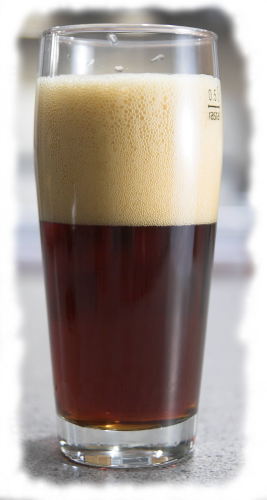Difference between revisions of "Imperator"
| Line 1: | Line 1: | ||
[[Image:Imperator.png|center]] | [[Image:Imperator.png|center]] | ||
| − | The Imperator Doppelbock is a classic German Doppelbock that is comparable to Spaten's Optimator without trying to be a clone. It is of a dark mahagony color without roasted notes in aroma or taste. Though intended to be complex in flavor it is also very drinkable. Mostly due to its starting extract of 18.5 Plato which puts it in the lower end of the range for Doppelbocks, but most commercial examples are fairly close to that range. This beer will take some time. After lagering it for 2 months, it should be aged for at least another 2 months. | + | The Imperator Doppelbock is a classic German Doppelbock that is comparable to Spaten's Optimator without trying to be a clone. It is of a dark mahagony color without roasted notes in aroma or taste. Though intended to be complex in flavor it is also very drinkable. Mostly due to its starting extract of 18.5 Plato which puts it in the lower end of the range for Doppelbocks, but most commercial examples are fairly close to that range. This beer will take some time. After lagering it for 2-3 months, it should be aged for at least another 2-3 months for the dark fruit notes to come out. |
| + | The traditional season for Doppelbock is Lent, which is the time from [http://en.wikipedia.org/wiki/Ash_Wednesday Ashwednesday] to Good Friday. Ashwednesday is generally towards the end of February. This means that the best time to brew this beer is September. This will give it 6 month to be ready for its season. | ||
= Water = | = Water = | ||
''for brewers who build their own water'' | ''for brewers who build their own water'' | ||
| + | |||
| + | This water treatment is for 34.5 l reverse osmosis water: | ||
| + | |||
| + | * 0.90g Table Salt (NaCl) | ||
| + | * 0.65g Epsom Salt (MgSO<sub>4</sub>7H<sub>2</sub>O) | ||
| + | * 2.00g Baking Soda (NaHCO<sub>3</sub>) | ||
| + | * 3.80g Chalk (CaCO<sub>3</sub>) | ||
| + | |||
| + | The resulting water should have a profile of: | ||
| + | 48 mg/l Ca, 3 mg/l Mg, 30 mg/l Na, 9 mg/l SO<sub>4</sub>, 20 mg/l Cl, 131 mg/l HCO<sub>3</sub> | ||
| + | |||
| + | While it is not important to match this water profile exactly, the following guidelines should be followed: | ||
| + | |||
| + | * residual alkalinity should be around 4 dH (degree German Hardness) or 80 mg/l HCO<sub>3</sub> | ||
| + | * the sulphates should be low since this beer doesn't emphasize the hops | ||
| + | * Calcium should be at least 40 - 50 mg/l since it is a yeast nutrient | ||
= Grist = | = Grist = | ||
Revision as of 17:11, 27 June 2008
The Imperator Doppelbock is a classic German Doppelbock that is comparable to Spaten's Optimator without trying to be a clone. It is of a dark mahagony color without roasted notes in aroma or taste. Though intended to be complex in flavor it is also very drinkable. Mostly due to its starting extract of 18.5 Plato which puts it in the lower end of the range for Doppelbocks, but most commercial examples are fairly close to that range. This beer will take some time. After lagering it for 2-3 months, it should be aged for at least another 2-3 months for the dark fruit notes to come out.
The traditional season for Doppelbock is Lent, which is the time from Ashwednesday to Good Friday. Ashwednesday is generally towards the end of February. This means that the best time to brew this beer is September. This will give it 6 month to be ready for its season.
Contents
[hide]Water
for brewers who build their own water
This water treatment is for 34.5 l reverse osmosis water:
- 0.90g Table Salt (NaCl)
- 0.65g Epsom Salt (MgSO47H2O)
- 2.00g Baking Soda (NaHCO3)
- 3.80g Chalk (CaCO3)
The resulting water should have a profile of: 48 mg/l Ca, 3 mg/l Mg, 30 mg/l Na, 9 mg/l SO4, 20 mg/l Cl, 131 mg/l HCO3
While it is not important to match this water profile exactly, the following guidelines should be followed:
- residual alkalinity should be around 4 dH (degree German Hardness) or 80 mg/l HCO3
- the sulphates should be low since this beer doesn't emphasize the hops
- Calcium should be at least 40 - 50 mg/l since it is a yeast nutrient


